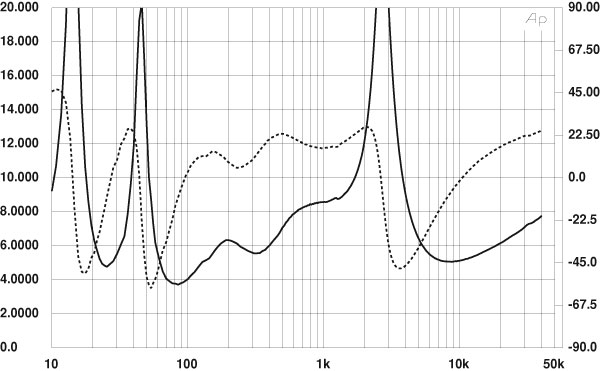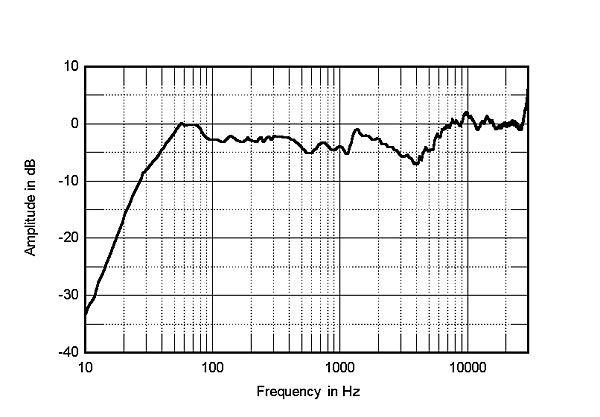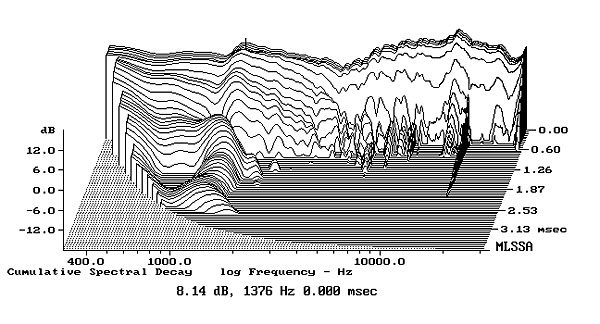| Columns Retired Columns & Blogs |
Pretty smart how you converged the tweeter axes. This is my dream tower; made in Sweden, it gives your system smooth pretentiousness. Pretty cool that it outdid the Revel Performas
I used DRA Labs' MLSSA system and a calibrated DPA 4006 microphone to measure the Marten Django XL's frequency response in the farfield, and an Earthworks QTC-40 mike for the nearfield responses. Because the Django XL is a large, heavy speaker, I could not raise it very high off the ground for the acoustic measurements. As a result, the measured responses have less resolution in the midrange than I would have liked.
My estimate of the Django's voltage sensitivity was 84.1dB(B)/2.83V/m, which is much lower than the specified 89dB/2.83V/m. Offsetting that, the speaker's plot of electrical impedance with its woofer control set to "+" (fig.1) indicates that it is not a difficult load for the partnering amplifier to drive. Although there is a minimum impedance of 3.8 ohms between 70 and 100Hz and a dip to 5.1 ohms in the high treble, for much of the audioband the impedance remains above 6 ohms, and with a generally low phase angle.

All things being equal, it is more difficult to control panel resonances in a large speaker than a small, and resonances in the former tend to be lower in frequency, hence potentially more deleterious to music. The top section of the Django XL's enclosure was relatively inert, with a single, low-level mode present at 320Hz on the sidewalls level with the midrange drive-unit (not shown). But the bottom section was more lively, as shown by fig.2, a cumulative spectral-decay plot calculated from the output of a plastic-tape accelerometer fastened to the center of one of the sidewalls level with the top woofer. A strong mode can be seen at 484Hz, as well as some lower-level resonances to its sides. It's difficult to predict the audibility of this behavior, as it depends on the frequency, the Q (Quality factor) of the resonance, the radiating area of the panel affected, and the acoustic phase of the panel's output. I note, however, Erick Lichte's comment that "the Djangos were remarkably free of boxy cabinet colorations in both the midrange and the bass."

The saddle centered on 27Hz in the impedance-magnitude trace (fig.1) suggests that this is the tuning frequency of the twin downward-firing ports. (The Django XL was supported on its outrigger bases fitted with cones for all measurements, to give the appropriate ground clearance for the ports.) The green trace in fig.3 shows the sum of the nearfield responses of the three woofers. (The top woofer actually rolls off a little more slowly than the other two.) The expected minimum-motion notch in the woofers' output, which is where the back pressure from the port resonance holds the cones stationary, lies at the same 27Hz, which suggests superb low-frequency extension. The output of the ports (fig.3, red trace) peaks between 20 and 40Hz, but its upper-frequency rolloff is disturbed by a series of resonant peaks. Fortunately, the fact that the ports fire downward, perhaps into a carpet, will minimize the audibility of this behavior. The woofers cross over to the midrange around the specified 250Hz, but with shallow filter slopes.

Fig.4 shows how the individual responses sum in the farfield on the tweeter axis. Below 300Hz, the trace shows the complex sum of the midrange, woofer, and port nearfield outputs, taking into account both acoustic phase and the different distances of each diaphragm from a nominal farfield microphone position. Despite the nearfield-measurement technique, there is only a slight rise in the midbass, suggesting that the Django's woofer alignment is somewhat overdamped. This is sensible, given the usual "room gain" that occurs at low frequencies. There is useful bass extension down to 30Hz or so, while the low-frequency control offers a maximum boost or cut in the level of the woofers of approximately 2dB.

Higher in frequency in fig.4, the Django offers a superbly flat midrange, but there is a peculiar peak at 1200Hz (this coincident with a wrinkle at the same frequency in the impedance traces), and above that a broad lack of presence-region energy. This will undoubtedly have a negative effect on the estimated sensitivity. The tweeter appears to be balanced between 3 and 5dB too high in level—EL noted that he "wouldn't be surprised if JA's measurements reveal that the Django's tweeter is dialed in a bit hot"—though this will tend to be compensated for in a typical room by the tweeter's increasing directivity in the same region (fig.5). This graph also reveals a slight flare at the base of the tweeter's passband, which will tend to compensate for the lack of on-axis energy in that region. In the vertical plane (fig.6), the Django's balance hardly changes up to 10° below the tweeter axis, which is a high 43" from the floor. A suckout at 3kHz develops more than 5° above the tweeter axis—don't listen to this speaker while standing or it will sound hollow.


The Django XL's step response on the tweeter axis (fig.7) shows that its tweeter and midrange unit are connected in inverted acoustic polarity, the three woofers in positive polarity, this confirmed by looking at the step responses of the individual units (not shown). The decay of each unit's step blends smoothly with the start of the next unit's, suggesting optimal crossover design. The cumulative spectral-decay plot on the tweeter axis (fig.8) is clean, especially in the region covered by the ceramic-dome tweeter, but that shallow peak in the upper midrange can be seen to be accompanied by a small amount of delayed energy.


Although there are some anomalies in the Django XL's measured performance, it looks as if Marten has carefully balanced things so that the overall sound in the room will be close to neutral.— John Atkinson

Pretty smart how you converged the tweeter axes. This is my dream tower; made in Sweden, it gives your system smooth pretentiousness. Pretty cool that it outdid the Revel Performas